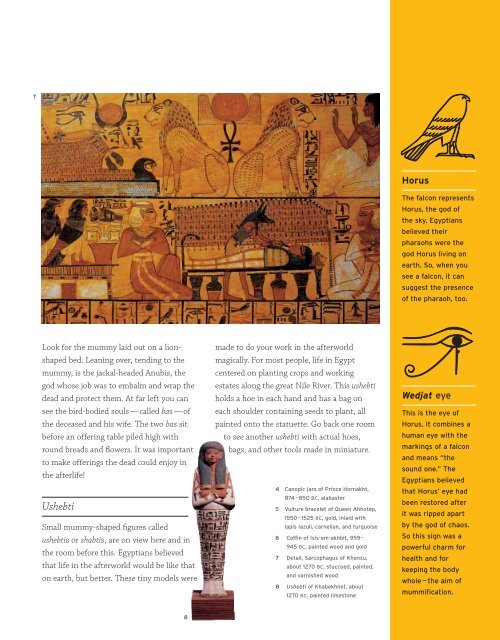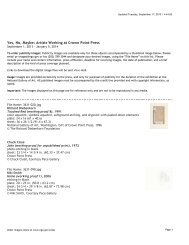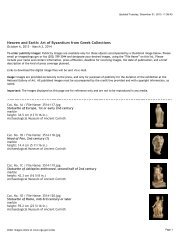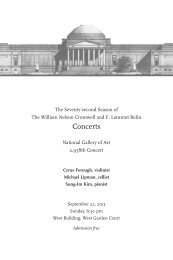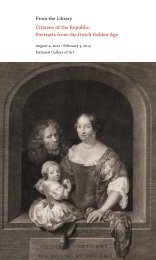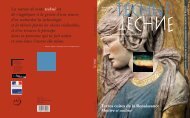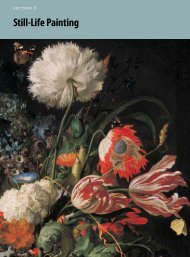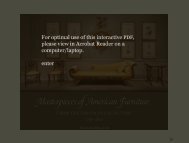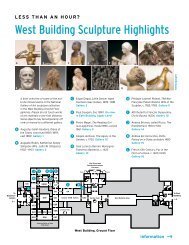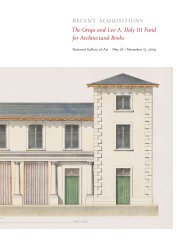The Quest for Immortality - National Gallery of Art
The Quest for Immortality - National Gallery of Art
The Quest for Immortality - National Gallery of Art
Create successful ePaper yourself
Turn your PDF publications into a flip-book with our unique Google optimized e-Paper software.
7<br />
Look <strong>for</strong> the mummy laid out on a lionshaped<br />
bed. Leaning over, tending to the<br />
mummy, is the jackal-headed Anubis, the<br />
god whose job was to embalm and wrap the<br />
dead and protect them. At far left you can<br />
see the bird-bodied souls—called bas—<strong>of</strong><br />
the deceased and his wife. <strong>The</strong> two bas sit<br />
be<strong>for</strong>e an <strong>of</strong>fering table piled high with<br />
round breads and flowers. It was important<br />
to make <strong>of</strong>ferings the dead could enjoy in<br />
the afterlife!<br />
Ushebti<br />
Small mummy-shaped figures called<br />
ushebtis or shabtis, are on view here and in<br />
the room be<strong>for</strong>e this. Egyptians believed<br />
that life in the afterworld would be like that<br />
on earth, but better. <strong>The</strong>se tiny models were<br />
8<br />
made to do your work in the afterworld<br />
magically. For most people, life in Egypt<br />
centered on planting crops and working<br />
estates along the great Nile River. This ushebti<br />
holds a hoe in each hand and has a bag on<br />
each shoulder containing seeds to plant, all<br />
painted onto the statuette. Go back one room<br />
to see another ushebti with actual hoes,<br />
bags, and other tools made in miniature.<br />
4 Canopic jars <strong>of</strong> Prince Hornakht,<br />
874 – 850 BC, alabaster<br />
5 Vulture bracelet <strong>of</strong> Queen Ahhotep,<br />
1550 – 1525 BC, gold, inlaid with<br />
lapis lazuli, carnelian, and turquoise<br />
6 C<strong>of</strong>fin <strong>of</strong> Isis-em-akhbit, 959 –<br />
945 BC, painted wood and gold<br />
7 Detail, Sarcophagus <strong>of</strong> Khonsu,<br />
about 1270 BC, stuccoed, painted,<br />
and varnished wood<br />
8 Ushebti <strong>of</strong> Khabekhnet, about<br />
1270 BC, painted limestone<br />
Horus<br />
<strong>The</strong> falcon represents<br />
Horus, the god <strong>of</strong><br />
the sky. Egyptians<br />
believed their<br />
pharaohs were the<br />
god Horus living on<br />
earth. So, when you<br />
see a falcon, it can<br />
suggest the presence<br />
<strong>of</strong> the pharaoh, too.<br />
Wedjat eye<br />
This is the eye <strong>of</strong><br />
Horus. It combines a<br />
human eye with the<br />
markings <strong>of</strong> a falcon<br />
and means “the<br />
sound one.” <strong>The</strong><br />
Egyptians believed<br />
that Horus’ eye had<br />
been restored after<br />
it was ripped apart<br />
by the god <strong>of</strong> chaos.<br />
So this sign was a<br />
powerful charm <strong>for</strong><br />
health and <strong>for</strong><br />
keeping the body<br />
whole — the aim <strong>of</strong><br />
mummification.


